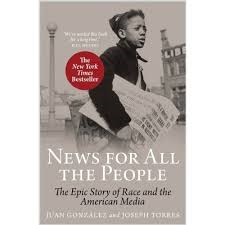News For All The People: A Book Review: Part Two

Here we go! This is part two of my book review of a history of the American news media system, written by Juan Gonzalez and Joseph Torres. As I said before, in part one, I am approaching this review as though I were making the educational documentary film for PBS, which this book deserves to be.
In part one I talked about something fun: the early days of public amateur radio. I explained how my filming technique would use a split-screen to show the parallel histories of the early days of wide open public-at-large radio and the early days the Internet, focusing on its social media applications.
As we have seen in part one, the story of the early American gold rush of radio---the "free-for-all," as some people call it---started to come to an end with the Radio Act of 1927.
Okay.
I should say that if I were making this documentary, it would be a ten-to-twelve hour affair, broken up into two-hour segments.

Then I would turn to part two of the film, the "epic story of race and the American media." But a more accurate formulation would probably be something like: "the epic story of race and the communications technology used by the American media."
You see, the thing I would be trying to put across is this: That the federal government, in response to the prevailing racial sentiment of the society, at various times, implemented policies that made the communications technologies used by the American news media into both a magnifying glass and a minimizing glass.
Magnifying glass for what? Minimizing glass for what?
A magnifying glass for demeaning stereotypes of nonwhites.
A minimizing glass for the concerns of nonwhites, and the attempts of these communities to push back against the stereotyping, as well as their attempts to tell their own stories in their own words.
Its not just me---the person writing this essay---saying this. This had been precisely the finding of the Kerner Commission in 1968. The report, in part, said this:
"If what the white American reads in the newspapers or sees on TV conditions his expectation of what is ordinary and normal in the larger society, he will neither understand nor accept the black American. By failing to portray the Negro as a matter of routine and in the context of the total society, the news media have, we believe, contributed to the black-white schism in the country" (1).
So, an entity known as the Kerner Commission believed, in 1968, that the American news media had "contributed to the black-white schism in the country."
What was the Kerner Commission?
The authors, Gonzalez and Torres, tell us:
"In 1967, more than eighty people died in outbreaks of racial violence in Detroit, Newark, and other US cities. Over the next two years, at least 1,100 racial disturbances occurred in every region of the country. Such riots became so pervasive for a time that national leaders grew justifiably fearful of a race war breaking out. President Lyndon Johnson created the National Advisory Commission on Civil Disorders, better known as the Kerner Commission, to investigate and report on the causes of the violence" (2).

So, the Kerner Commission was an advisory panel created by the Executive Branch of President Lyndon Johnson, in the 1960s. And this government advisory body blamed the American news media for contributing to the "black-white schism."
Let's read a little further. Again, Gonzalez and Torres:
"The Commission's groundbreaking report, issued in the spring of 1968, reached the startling conclusion that, despite the abolition of slavery a century earlier, and despite the inroads made against the Jim Crow system after the Supreme Court's Brown decision, the nation was 'moving toward two societies, one black, and one white---separate and unequal.' The report particularly faulted the press for exacerbating the racial divide. 'Far too often, the press acts and talks about Negroes as if Negroes do not read newspapers or watch television, give birth, marry, die, and go to PTA meetings,' the report stated. African-Americans, it warned, harbored a deep mistrust and 'contempt' of the news media; they regard journalists as instruments of the 'white power structure,' too often simply publishing information they received from authorities during racial troubles without even speaking with members of the affected communities. A primary reason for the failures of the media in this area, the Commission concluded, was the absence of black journalists in mainstream newsrooms. Press executives had been 'shockingly backward in seeking out, hiring, training and promoting Negroes,' with only 5 percent of all newsroom employees and just 1 percent of editors and supervisors being black, most of them working for black-owned companies. The report urged a concerted effort by the entire industry to hire and promote non-whites in all areas of news organization, and it called for the creation of a new 'Institute of Urban Communications' to train young blacks for jobs in journalism" (3).
As I said before, you study the history of a thing to figure out its nature, to understand why it is the way it is today. And as I also said, Gonzalez and Torres' book shows how the various communications technologies used by the American news media---from the very first colonial times newspaper, Publick Occurrences to the Internet---were additionally empowered by government policies, to act as both the magnifying glass and minimizing glass.
The first thing my documentary would go to would be the way federal postal policy empowered early American newspapers to act as both magnifying glass and minimizing glass.
Gonzalez and Torres:
"No single policy of the federal government so shaped the creation and evolution of Americans' news media system as did the Postal Act of 1792. Its passage by Congress sparked a communications revolution that 'transformed the role of newspapers in American life.' Over the next hundred years the Post Office methodically fashioned an elaborate system of post roads and delivery routes that connected virtually every citizen to a vast and unprecedented information network. As the territorial boundaries of the United States leaped at breathtaking speed across the entire continent, the Post Office, its legion of postmasters stationed in every town and village, became what historian Richard R. John has termed the 'central administrative apparatus' of the United States" (4).
That is one of the things government policy did for newspapers.
In my film I would next show what government policy did for the next technology: the telegraph.
Next would be radio.
Nest would be television.
Next would be the Internet. I would show how government policy helped to make these instruments into a magnifying and minimizing glass, as it pertains to nonwhite racial stereotypes and the ability of nonwhites to push back and tell their own stories in their own words.
The third part of my documentary would talk about something relatively fun again. It would talk about the rich and vibrant non-white press tradition, which Gonzalez and Torres detail in News For All The People. For example, I think a lot of people would be startled to learn of the indigenous newspaper and radio tradition, the Chinese-, Korean-, and Japanese-American news media tradition; and, of course, most Americans are probably somewhat more familiar with the African-American media tradition.
The reason for the emergence of this nonwhite media structure was to push back against their caricatured depictions by the mainstream white American press; and to, sometimes, push back more broadly against something called the white racial narrative.
Authors Gonzalez and Torres define the white racial narrative this way: As the "creation myth of heroic European settlers battling an array of backward and violent non-white peoples to forge the world's greatest democratic republic" (5).
The fourth part of my documentary would talk about how the news media system played its role in actually inciting racial violence. Chapter three of News For All The People is titled: "Inciting to Riot: The Age of Jackson." I would detail the specific incidents Gonzalez and Torres detail, of course.
But just to give you an idea about what we would be looking at, allow me to quote the two authors again:
"This chapter traces the role played by many of the nation's most influential nineteenth-century editors in spreading bigoted views and instigating racial violence. It also examines how the commercial and labor press, by championing territorial conquest of Mexican and Latin American lands, helped to legitimize white-supremacist notions of Manifest Destiny in the public imagination" (6).
For the fifth part of my documentary, I would do something relatively positive again, by discussing how "the government was forced on several occasions to adopt important reforms that made the press more democratic and accountable to ordinary citizens, usually in an effort to placate incipient social movements or to quell civil strife, especially during times of war" (7).
For part six and the conclusion, I think I would just do what chapter 17 of Gonzalez and Torres's book indicates from its title. I would talk about "Controlling the Means of Transmission: Old Media's Fall and New Media's Rise."
That'll do it, I think.
Thank you so much for reading!
References
1. Gonzalez, Juan & Torres, Joseph. News For All The People: The Epic Story of Race and the American Media. Verso, 2011; (first paperback edition, 2012). 301
2. ibid, 303-304
3. ibid, 304
4. ibid, 31
5. ibid, 3
6. ibid, 41
7. ibid, 2






